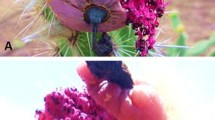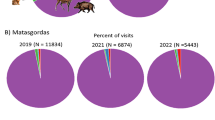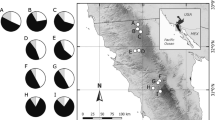Summary
The fate of fruits from a population of European hawthorn (Crataegus monogyna) in western Oregon, USA, was examined over a two-year period. Only one frugivore, the American robin (Turdus migratorius) foraged on the C. monogyna fruits, making this an unusually straightforward fruit-frugivore system. Dispersal efficiency was low, with an average 21% of seeds being dispersed (carried away from parent plants) each year; the most common fate of fruits was to simply fall. Robins dropped 20% of the fruits that they picked, and defecated/regurgitated 40% of the fruits (seeds) that they swallowed, beneath parent plants. One trait, gruit abundance, strongly affected the probability of bush visitation by robins, bushes with larger fruit displays being preferred. Both absolute dispersal success (number of seeds) and dispersal efficiency (proportion of seeds; success per propagule) were also found to be correlated most strongly with initial fruit abundance. Individual plant fecundity and fruit quality were found to vary little between years; as a result, dispersal efficiencies for individual plants were also annully consistent. Larger (older) plants produced more fruits and therefore had higher fitness. These results suggest that the optimal fruiting strategy for C. monogyna is therefore to get as big as possible as quickly as possible by delaying fruiting until later in life.
Similar content being viewed by others
References
Bass DA (1990) Dispersal of an introduced shrub (Crataegus monogyna) by the Brush-tailed Possum (Trichosurus vulpecula). Aust J Ecol 15:227–229
Borowicz VA, Stephenson AG (1985) Fruit composition and patterns of fruit dispersal of two Cornus spp. Oecologia 67:435–441
Burger AE (1987) Fruiting and frugivory of Cornus canadensis in boreal forest in Newfoundland. Oikos 49:3–10
Courtney SP, Manzur MI (1985) Fruiting and fitness in Crataegus monogyna: the effects of frugivores and seed predators. Oikos 44:398–406
Davidar P, Morton ES (1986) The relationship between fruit crop sizes and fruit removal rates by birds. Ecology 67:262–265
De Boer JI (1979) Dispersal of Crataegus L. (hawthorn) in southwestern Ontario. Honours Project, University of Western Ontario
Estrada A, Fleming TH (eds) (1986) Frugivores and seed dispersal. Junk, Boston
Foster RB (1982) Famine on Barro Colorado Island. In: Leigh EG Jr, Rand AS, Windsor DS (eds) The ecology of a tropical forest: seasonal rhythms and long-term changes. Smithsonian Press, Washington, DC, pp 201–212
Harper JL (1977) Population biology of plants. Academic Press, New York
Herrera CM (1982) Seasonal variation in the quality of fruits and diffuse coevolution between plants and avian dispersers. Ecology 63:773–785
Herrera CM (1987) Vertebrate-dispersed plants of the Iberian peninsula: a study of fruit characteristics. Ecol Monogr 57:305–331
Herrera CM, Jordano P (1981) Prunus mahaleb and birds: the high-efficiency seed dispersal system of a temperate fruiting tree. Ecol Monogr 51:203–218
Howe HF (1980) Monkey dispersal and waste of a neotropical fruit. Ecology 61:944–959
Howe HF (1981) Dispersal of a neotropical nutmeg (Virola sebifera) by birds. Auk 98:88–98
Howe HF (1983) Annual variation in a neotropical seed-dispersal system. In: Sutton SL, Whitmore TC, Chadwick AC (eds) Tropical rain forests: ecology and management. Blackwell, London, pp 211–227
Howe HF (1986) Seed dispersal by fruit-eating birds and mammals. In: Murray DR (ed) Seed dispersal. Academic Press, New York, pp 123–190
Howe HF (1989) Scatter- and clump-dispersal and seedling demography: hypothesis and implications. Oecologia 79:417–426
Howe HF, De Steven D (1979) Fruit production, migrant bird visitation, and seed dispersal of Guarea glabra in Panama. Oecologia 39:185–196
Howe HF, Estabrook GF (1977) On intraspecific competition for avian dispersers in tropical trees. Am Nat 111:817–832
Howe HF, Smallwood J (1982) Ecology of seed dispersal. Annu Rev Ecol Syst 13:201–228
Howe HF, Vande Kerckhove GA (1979) Fecundity and seed dispersal of a tropical tree. Ecology 60:180–189
Howe HF, Vande Kerckhove GA (1981) Removal of wild nutmeg (Virola surinamensis) crops by birds. Ecology 62:1093–1106
Howe HF, Schupp EW, Westley LC (1985) Early consequences of seed dispersal for a neotropical tree (Virola surinamensis). Ecology 66:781–791
Jordano P (1982) Migrant birds are the main seed dispersers of blackberries in southern Spain. Oikos 38:183–193
Jordano P (1987) Avian fruit removal: effects of variation, crop size and insect damage. Ecology 68:1711–1723
Jordano P (1989) Pre-dispersal biology of Pistacia lentiscus (Anacardiaceae): cumulative effects on seed removal by birds. Oikos 55:375–386
Love R (1980) Insect feeding on indigenous and introduced hawthorns. PhD Dissertation, University of Oregon, pp 163
Love R, Feigen M (1978) Interspecific hybridization between native and naturalized Crataegus (Rosaceae) in western Oregon. Madroño 25:211–217
Manasse RS, Howe HF (1983) Competition for dispersal agents among tropical trees: influences of neighbors. Oecologia 59:185–190
Manzur MI, Courtney SP (1984) Influence of insect damage in fruits of hawthorn on bird foraging and seed dispersal. Oikos 43:265–270
McKey D (1975) The ecology of coevolved seed dispersal systems. In: Gilbert LE, Raven PH (eds) Coevolution of animals and plants. University Texas Press, Austin, pp 159–191
Moore LA, Willson MF (1982) The effect of microhabitat, spatial distribution, and display size on dispersal of Lindera benzoin by avian frugivores. Can J Bot 60:557–560
Murray KG (1987) Selection for optimal fruit-crop size in birddispersed plants. Am Nat 129:18–31
Phipps JB, Muniyamma M (1980) A taxonomic revision of Crataegus (Rosaceae) in Ontario. Can J Bot 58:1621–1699
Pyke GH, Pulliam HR, Charnov EL (1977) Optimal foraging: a selective review of theory and tests. Q Rev Biol 52:137–154
Roiberg BD, Van Lenteren JC, Van Alphen JJM, Galis F, Prokopy RJ (1982) Foraging behavior of Rhagoletis pomonella, a parasite of hawthorn (Crataegus viridis), in nature. J Anim Ecol 51:307–325
Sallabanks R (1992) Fruits and frugivores: interactions and decision-making mechanisms. PhD Dissertation, University of Oregon, pp 180
Sallabanks R, Courtney SP (1992) Avoiding the early bird: frugivory, seed predation, and insect-vertebrate interactions. Annu Rev Entomol 37:377–400
Snow DW (1971) Evolutionary aspects of fruit-eating by birds. Ibis 113:194–202
Sokal RR, Rohlf FJ (1981) Biometry. WH Freeman, San Francisco
Sorensen AE (1981) Interactions between birds and fruit in a temperature woodland. Oecologia 50:242–249
Stephenson AG (1981) Flower and fruit abortion: proximate causes and ultimate functions. Annu Rev Ecol Syst 12:253–279
Thompson JN (1985) Postdispersal seed predation in Lomatium spp. (Umbelliferae): variation among individuals and species. Ecology 66:1608–1616
Wheelwright NT (1986a) The diet of American robins: an analysis of US Biological Survey records. Auk 103:710–725
Wheelwright NT (1986b) A seven-year study of individual variation in fruit production in tropical bird-dispersed tree species in the family Lauraceae. In: Estrada A, Fleming TH (eds) Frugivores and seed dispersal. Junk, Boston, pp 18–35
Wheelwright NT (1988) Fruit-eating birds and bird-dispersed plants in the tropics and temperate zone. Trends Ecol Evol 10:270–274
Williams PA, Buxton RP (1986) Hawthorn (Crataegus monogyna) populations in mid-Canterbury. N Z J Ecol 9:11–17
Willson MF (1986) Avian frugivory and seed dispersal in eastern North America. Curr Ornithol 3:223–279
Willson MF, Whelan CJ (1990) Variation in postdispersal survival of vertebrate-dispersed seeds: effects of density, habitat, location, season, and species. Oikos 57:191–198
Author information
Authors and Affiliations
Rights and permissions
About this article
Cite this article
Sallabanks, R. Fruit fate, frugivory, and fruit characteristics: a study of the hawthorn, Crataegus monogyna (Rosaceae). Oecologia 91, 296–304 (1992). https://doi.org/10.1007/BF00317800
Received:
Accepted:
Issue Date:
DOI: https://doi.org/10.1007/BF00317800




